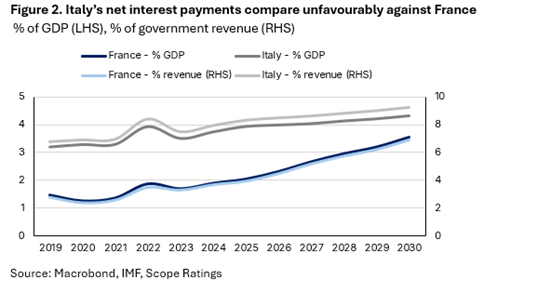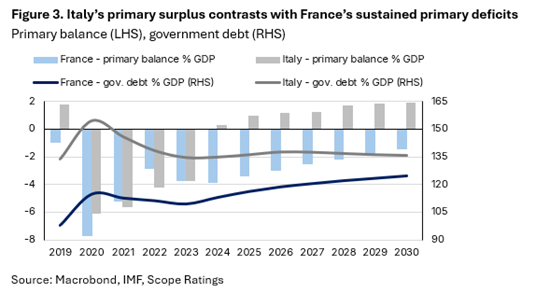Announcements
Drinks
France vs Italy: converging sovereign bond spreads mask different credit fundamentals
By Thomas Gillet and Carlo Capuano, Sovereign and Public Sector
The Negative Outlook that we assigned to France’s AA- long-term ratings on 26 September signals potential further credit rating convergence towards Italy, whose Outlook we revised to Positive on the BBB+ long-term ratings on 31 October. Following France’s downgrade to AA- in October 2024, Italy’s spreads have narrowed significantly to those of France (Figure 1).

Recent economic and external developments point to shared strengths…
Both countries have a similar economic outlook, with real GDP growth projected at 1% on average in France against 0.8% for Italy over the 2025-30 period despite investment driven by NGEU funds. Similarly, both countries have introduced labour-market reforms supporting the recent decline in the unemployment rate to 7.6% in France and 6.1% in Italy.
The two countries have also proved resilient to recent shocks, including to higher United States (AA-/Stable) tariffs (the second largest export market after the EU), due to their diversified economies, robust private sector balance sheets, and strong banking sectors.
One point of difference in favour of Italy’s credit profile is the country’s current account surplus, projected at around 1.5% of GDP on average by 2030 and its net international creditor position of 11% of GDP as of Q2 2025, which contrasts with France’s balanced current account and net debtor position (22% of GDP).
…while economic, fiscal stock variables, debt affordability favour France
France remains wealthier on a per capita basis, also reflecting higher productivity and growth, which are long-standing weaknesses of Italy’s credit profile.
The gap between France’s and Italy’s nominal GDP, which has steadily widened since the early 2000s, is projected to persist until 2030. Similarly, France’s GDP per capita is expected to remain about 5% larger than Italy’s in coming years, at around 64,000 international dollars in 2024 vs 61,000 in Italy.
Moreover, France’s lower general government debt, standing at 115% of GDP in Q2 2025 against Italy’s 138%, and still moderate net interest payments provide more fiscal headroom to navigate delays in fiscal consolidation and a challenging political outlook, as well as any potential external shocks (Figure 2).
Conversely, Italy’s higher interest burden and subdued growth outlook, which points to a relatively weaker shock absorption capacity, are challenges for debt sustainability.
Although both countries have a long debt maturity – 8.6 years for France, 7.1 years for Italy – higher refinancing rates will feed through France’s interest burden more gradually given Italy’s larger stock of debt-to-GDP and higher gross funding needs. France’s net interest payments as share of revenues are projected to increase to about 7% by 2030 from 4% of revenue in 2025, which would still be lower than Italy’s 8% in 2024 (Figure 2).

Despite its primary surplus, Italy’s planned 2026 funding programme (EUR 350-400bn, or around 16-18% of GDP) is higher than France’s (EUR 310bn for medium- and long-term issues net of buybacks, or around 10% of GDP). Even so, strong debt management in both countries and supportive European monetary- and fiscal-policy frameworks support resilience.
Italy’s is further supported by a relatively large, although declining, share of general government debt held by residents, estimated at slightly below 70%. France is more dependent on non-resident investors (about 50% of total) who could be more sensitive to domestic and international political uncertainty.
Furthermore, the fiscal costs associated with an ageing population, defence investment, climate and digital transitions look more benign in France than in Italy. France has a more favourable demographic outlook with an old age dependency ratio projected at 50% in 2050 against more than 60% in Italy, according to the European Commission 2024 Ageing report.
France also seems better positioned to gradually increase defence spending towards 2.5% of GDP against 2.2% for Italy in 2026 despite a similar tentative allocation under SAFE funds (at around 0.5-0.6% of GDP). This reflects France’s longstanding investments and a large defence industrial base supporting its leading role in Europe’s security.
France’s stronger position for climate and digital transitions – based on its fleet of nuclear power stations and digital ecosystem – could also better mitigate associated fiscal costs considering Italy has one of the higher energy imports dependency rates among EU member states, running at 75% in 2023 compared with 45% in France.
Rating convergence now more likely given Italy’s stable, fiscally prudent government
France’s high budget deficits and uncertain fiscal consolidation remain credit challenges. The recent suspension of the 2023 pension reform (increasing the retirement age to 64) until 2027 could further weigh on spending allocated to social protection (34% of GDP in France; 29% in Italy).
Recent political instability and policy uncertainty after the next presidential election in April-May 2027 further cloud the outlook to reduce the budget deficit below 3% of GDP by 2030 – a target that Italy is estimated to have achieved already this year. This underpins our projection that France’s general government debt is likely to remain on an upward trend over the next five years.
In the near-term and in the absence of shocks, Italy’s fiscal dynamics are more favourable given its primary surplus driven by effective fiscal consolidation, political stability and expected policy continuity possibly after the general election in December 2027.
Although the 2026-28 budget plan includes tax cuts for middle-income earners, Italy’s primary surplus will increase steadily to more than 1.8% by 2030 from 0.5% of GDP in 2024 in a baseline scenario, leading to the stabilisation of government debt-to-GDP at a still elevated 136%, partially mitigating associated debt-sustainability concerns.
On that basis, our projection is that the differential between France’s and Italy’s debt-to-GDP will gradually decline but remain substantial, at around 15 percentage points on average by 2030 (Figure 3).







